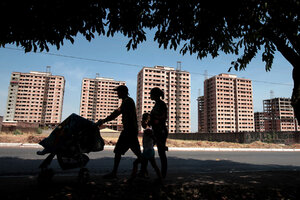State of the world: U.N. poverty-reduction goals on track
Part 4 of the surprisingly upbeat state of the world: U.N. global poverty-reduction goals are met.

In this Sept. 23 photo, a family walks past a residential complex under construction in Ceilandia, in Brasilia state, Brazil. Millions of Brazilians have moved out of poverty and joined the ranks of the middle class, helping to create a strong domestic market allowing the country to resist the worst impacts of global economic crisis.
Eraldo Peres/AP
Washington
Eleven years ago, at the Millennium Summit at United Nations headquarters in New York, the leaders of the world agreed to a plan meant to spur efforts to help the globe's poorest.
This blueprint involved a series of benchmarks – Millennium Development Goals – to measure the progress of developing nations on poverty, hunger, primary education, and so forth. The point was to rally international efforts to try to bring a better life to those who most needed it by 2015.
Well, 2015 is rapidly looming into view, insofar as development is concerned. And right now it looks as if most of the nations involved are going to reach most of the objectives.
Related: New US poverty formula
"Two-thirds of developing countries are on track or close to meeting the Millennium Development Goals," begins the World Bank's "Global Monitoring Report 2011."
The world will easily meet the overall goal on poverty, for instance, if indeed the number of people living on less than $1.25 per day falls to the expected 883 million in 2015.
True, much of the progress against poverty stems from the economic gains of China and India, two huge capitalist economies that have grown rapidly in recent decades. But this growth wasn't foreordained, and the world should celebrate the fact that an enormous number of ordinary Chinese and Indians now can live better lives, say officials at nongovernmental development organizations.
And China and India aren't alone. Among the nations that have either halved poverty already or will do so by 2015 are Cambodia, Central African Republic, Ethiopia, Ghana, Kenya, and Mauritania.
What's led these and other lower-income countries to start climbing out of the economic basement? Good policies in regard to controlling domestic government budgets and currencies, plus rising prices for the commodities on which many poorer nations depend for export earnings. Overall, 80 percent of developing nations should meet the poverty goal.
"On the whole, the fight against poverty is progressing well," says the "Global Monitoring Report 2011."
Economic growth tends to be a foundation from which progress on other measures of well-being can build. Consider hunger, for instance. It's obvious that as the world's poorest people gain more money, food is one of the first things they spend it on. Indeed, the world is on track to halve extreme hunger in many of the same places where poverty is declining. About 45 percent of developing nations have already reached this goal. And 33 percent are close.
Education is another area helped by economic progress. One of the Millennium Development Goals (MDGs) in this area is for developing nations to provide access to primary schooling for all children who want it, boys and girls. Eighty-three percent of developing nations are either close to this benchmark or have reached it.
"Economic growth tends to affect very quickly other MDGs," says World Bank economist Delfin Go. But growth alone doesn't solve all of a poor nation's problems, he adds. In many cases, systems of aid delivery need to be improved to trigger social gains. For instance, while primary education enrollments in developing nations have climbed in recent years, learning outcomes haven't kept pace. In India, most young children are enrolled in primary school, but some 40 percent can't do simple subtraction.
And reaching the MDGs is only one step. The World Bank notes that within countries that are making progress, there remain pockets of deprivation, often concentrated among socially excluded groups.
Plus, there is a lower tier of nations that remains mired in misery. Many of these are states with ineffective or corrupt governments in sub-Saharan Africa. Poverty there has fallen since 2000, but the region as a whole is likely to miss the 2015 poverty reduction goal.
Still, at least this poorest of the world's areas appears to be moving forward. The International Monetary Fund (IMF) predicts that overall real gross domestic product growth in sub-Saharan Africa will reach 5.25 percent to 5.75 percent in 2011-12.
"The region is poised for continued economic expansion in the near term, provided the recent rise in financial and economic instability in major advanced economies remains contained," predicts an IMF World Economic Outlook from September.
